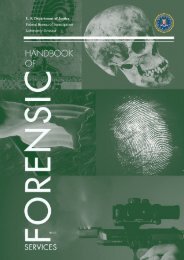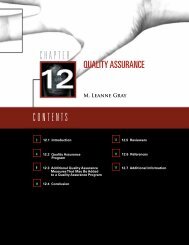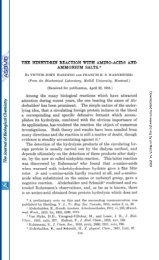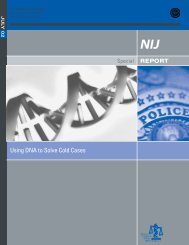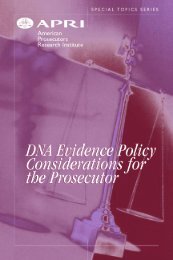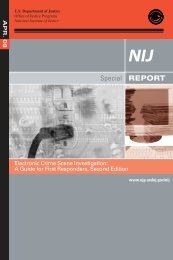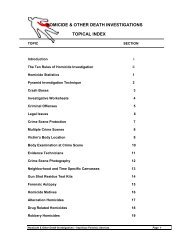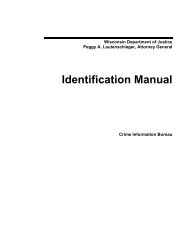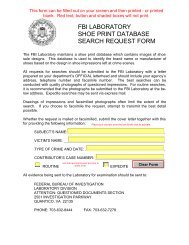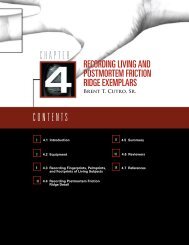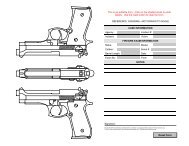Mass Fatality Incidents: A Guide for Forensic Identification
Mass Fatality Incidents: A Guide for Forensic Identification
Mass Fatality Incidents: A Guide for Forensic Identification
- No tags were found...
Create successful ePaper yourself
Turn your PDF publications into a flip-book with our unique Google optimized e-Paper software.
SPECIAL REPORT / JUNE 05each piece of evidence. This function alsoincludes safeguarding all potential physicalevidence and/or property and clothing thatremain on the deceased.Procedure. The medical examiner/coroneris expected to—A. Limit access to entry/exit areas:1. Maintain and update a registryof solicited volunteers and theirqualifications.2. Maintain and update a registry ofunsolicited volunteers (whose servicesmay or may not be required).B. Issue/verify identification badges withphotographs or other secure identifiers(e.g., thumbprints).C. Determine/review staffing needsand ensure adequate facilities andequipment.D. Differentiate normal from mass fatalitymorgue cases.E. Assign reasonable work schedules.F. Consider providing stress managementcounseling <strong>for</strong> the remains/evidence processing teams, morguestaff, and their families.G. Maintain a daily activity log thatrecords:1. The identification, reassociation,and disposition of all remains.2. An inventory of donated, loaned, orpurchased items.Summary. Implementing morgue operationand security procedures facilitatesthe proper identification of the deceased,maintains a proper chain of custody, andsafeguards property and evidence.III. Examine and DocumentRemainsPrinciple. The examination and documentationof remains provides detailed in<strong>for</strong>mationabout the deceased’s physicalattributes and the possible cause, manner,and circumstances of death. The medicalexaminer/coroner is responsible <strong>for</strong> maintainingall records and documentation,including notes, diagrams, photographs,radiographs/x-rays, fingerprints, and otherimages.Procedure. The medical examiner/coroneris expected to—A. Document where the remains werefound and where death occurred.B. Control and document how theremains are transported from thescene to the morgue.C. Ensure that all remains are properlyphotographed.D. Document the presence or absence ofclothing and personal effects.E. Diagram/describe in writing itemsof evidence and their relationship tothe remains (with necessarymeasurements).F. Document general physicalcharacteristics.G. Document the presence or absenceof specific marks, scars, tattoos, andexternal prostheses:1. Ensure total body radiographs/x-raysare made (if indicated).2. Provide anthropological consultation(if indicated).H. Document the presence or absence ofinjury/trauma.I. Document fingerprints (and handprints,toe prints, or footprints ifindicated).16




